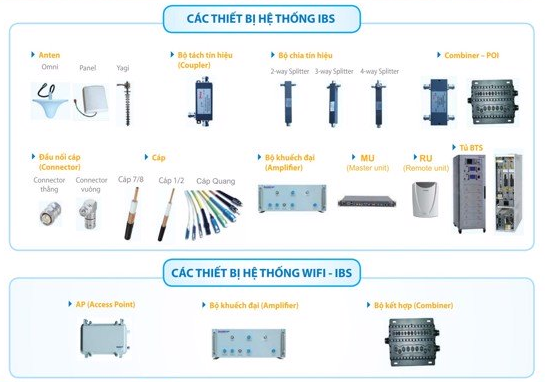At BUILDINGs (Trading Center, Hospital, Hotel, Building Complex...), AIRPORT, METRO, TUNNEL...: The quality of the mobile signal is poor. setting up calls, difficult conversations...especially in basements, elevators, hidden corners, high floors... So what's the reason?
What causes poor signal quality in buildings?
- Due to the coverage area: The buildings are out of reach of the coverage area from the outdoor BTS transceiver stations, due to the structure, construction materials of the building... obstructing and absorbing the wave signal. Mobile phone is interrupted, much loss leads to weak indoor coverage, even in areas where there is no signal.
In addition, before the rapid urbanization, there are many other high-rise buildings around the high-rise buildings, causing obstruction, limiting the mobile signal, and limiting the coverage area in the building.
- Due to capacity: At AIRPORT, METRO, HIGH BUILDING, HOSPITAL... is where many subscribers gather with high frequency of use, leading to call congestion.
- Due to quality:
+ Frequent mobile signal interference of the top floors of the building and unstable signal of the service area.
+ The effect of interference as well as the handover phenomenon of adjacent cells around the building.
+ Other causes ... make voice quality bad, even dropped.
IBS - PERFECT SOLUTION
Concept
IBS signal coverage system in the building (IBS) is the solution to build the system to establish optimal coverage for Building by leading the mobile signal from the base BTS station and distributing it through the Antenna system. Mobile phones cover the building space including basements, elevators, hidden corners... in order to:
- Ensure wide coverage with high signal quality
- Ensure signal stability to maintain the best call quality and service for mobile subscribers
- Meeting capacity requirements to serve a large number of subscribers with high frequency of use.
Structure
The IBS system consists of two main parts:

The original signal part (Signal Source): This part is responsible for generating signals for the system to operate as well as signal amplification and signal conversion, including:
+ Signal source system: Generating the main signal is a BTS transceiver station for GSM, CDMA, WDMA, LTE...
+ Coordination and amplification system: Includes Booster, Combiner, Adapter...
Distributed Antenna System (DAS) part: This part is responsible for conducting and distributing mobile signals throughout the building space, including:
+ Main shaft cabling system
+ Horizontal cabling system
+ Antenna System Indoor

EQUIPMENT SYSTEM IBS
1. Antenna
Due to the characteristic of the inbuilding system that mobile coverage is limited to a certain area with different specific spatial structures (corridor area, elevator area, underground area...) Antennas with technical characteristics to optimize design and use, include the following types:
+ Omni Antenna
+ Antenna Panel
+ Antenna Log
However, with the system in Metro, Tunnel of subway, other underground traffic works will use radiation cable (Leacky Cable).
Leaky Cable is shaped like a coaxial cable running along a tunnel, which functions as a system of antennas that transmit and receive radio signals.
Leaky Cable
2. Cable (Cable)
The IBS system in Building uses 2 main types of Cables:
+ Coaxial cable: Feeder 1/2, Feeder 7/8
+ Optical cable (Optical cable)
3. Splitter
As IBS materials used in buildings, the solution to deploying coverage is cabling. That is, the wave will propagate from the indoor BTS station along the cable to the antenna. As you know, the current buildings are all high-rise buildings, so when taking the cable, you have to branch and divide the capacity appropriately. That is also the reason we use the splitter. There are many dividers: divider 2, divider 3... depending on the requirements that we use which type.
In each different divider, the attenuation parameter (split loss) is different. Above are the parameters of a 2 splitter. The more dividers, the bigger the split loss.
4. Coupler
Is an IBS consumable that is essentially the same as a 2nd splitter, but the divider is uneven. It is used when we want to adjust the transmit power. Coupler also has many types: 5dB, 6dB, 7dB…
5. Cable connector (Connector)
6. Combiner or POI . sets
There are many service providers that want coverage in the same building. But if each supplier installs a separate system, it will be very expensive. In addition, it is unsightly, because there are too many antennas. Therefore, the solution for IBS supplies is to use POI sets (or Combiner). To combine broadcasting of different carrier frequencies on one system. Combiner device has the effect of combining input frequencies and output frequencies at the same carrier frequency. In POI devices, filters are used for frequencies. Therefore, using POIs has the advantage of not causing interference compared to using Combiner.
7. Amplifiers
Amplifier devices are often used in IBS for Buildings, Airports... with large areas, in order to meet the signal level to the Antennas in areas far from the BTS cabinets of the system.
